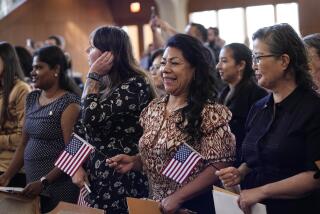New center for ‘dance medicine’
Young dancers sprain ankles. Aging dancers face knee and hip replacements. And along with the wear and tear -- the fractures, ruptures, strains and bruises that can threaten a dancer’s career and well-being -- comes an ever greater need for customized treatment.
Today, though, brings a new option for worn-down members of the local dance community: the opening at Cedars-Sinai Medical Center of a facility specializing in dance medicine.
For the record:
12:00 a.m. March 21, 2007 For The Record
Los Angeles Times Wednesday March 21, 2007 Home Edition Main News Part A Page 2 National Desk 2 inches; 69 words Type of Material: Correction
Dance facility: An article in Monday’s Calendar about the new Cedars-Sinai/USC Dance Medicine Center identified co-founder Margo Apostolos as director of USC’s Dance and Movement Program. It is the School of Theatre Dance Program. Also, Apostolos was reported to have held sports-medicine posts at Stanford, NASA and the Jet Propulsion Laboratory. In fact, she taught at Stanford and worked in space telerobotics at JPL as a NASA/ASEE Faculty Fellow.
The first of its kind in Los Angeles, the Cedars-Sinai/USC Dance Medicine Center will offer comprehensive injury treatment, rehabilitation and preventive care tailored to professional and recreational dancers.
It joins the Harkness Center for Dance Injuries in New York and the recently announced Institute for Dance Medicine at the University of Washington in Seattle as one of only a handful of such facilities in the country.
The center, in Cedars-Sinai’s Mark Goodson Building, came about through the collaborative efforts of Cedars-Sinai orthopedic surgeon Glenn Pfeffer and dancer Margo Apostolos, director of USC’s Dance and Movement Program. Under their direction, the center will address a broad spectrum of dance- and movement-related injuries.
“We want to treat dancers of all areas and all ages,” Apostolos said. Los Angeles represents a greater population of people who engage in one form of dance or another -- including salsa, folkloric and hip-hop -- than any other city in the world, said Pfeffer, a foot and ankle specialist. “We think in terms of all athletics that involve motion and jumping, from aerobics to ice skaters and cheerleaders,” he said.
The new center’s full-time medical team was recruited from Cedars-Sinai staff and chosen for expertise in sports medicine and related areas and for an expressed interest in dance, added Pfeffer, a onetime competitive ballroom dancer who was sidelined by a foot injury.
The team consists of three physical therapists trained in the treatment of dance conditions and five “dance doctors” -- orthopedists with foot and ankle, knee and shoulder, back and hip, and adolescent and adult sports-medicine specialties.
Beyond treating injuries, the goal of the center, which also features a Pilates gym and underwater treadmills, is to teach dancers to prevent injuries and to treat them with an emphasis on minimally invasive surgical techniques that result in the ability to bear weight on the injured limb sooner and in quicker recovery of range of motion, Pfeffer said.
“I think it’s invaluable,” said Joe Tremaine, L.A.-based choreographer, dancer and teacher. “To have this localized in L.A. will be beneficial to L.A. dancers in the professional and amateur dance communities and to any visiting company.”
Scientific research related to movement injuries, including the use of motion capture as a diagnostic tool, is another planned component. The center will also “plug in” to national dance medicine programs, Pfeffer said.
Apostolos, a member of the International Assn. for Dance Medicine and Science, has held sports-medicine positions at Stanford, NASA and the Jet Propulsion Laboratory in La Canada Flintridge.
“I think that a significant part of my role in this center,” she said, “is to be the voice of dance, the liaison who works with the dancers and can communicate to the doctors.”
To that end, as part of preparations during the last year, surgeons and therapists chosen to work for the center were asked to don leotards themselves.
“It’s what I call my ‘dance for doctors’ class,” Apostolos said.
“It did two things,” said Pfeffer, who participated. “One, there was education, and two, the quotes we got were, ‘This is hard.’ ” That kind of empathy is essential, he thinks.
One potential problem for the center is that dancers, who notoriously exist on a shoestring without company benefits, may not be able to readily avail themselves of its assistance. As part of the Cedars-Sinai hospital, it is a private facility.
Pfeffer acknowledged that “the problem with healthcare in general in the U.S. is that many people are uninsured.” But “that said, we’re all committed to helping the dance community as much as we possibly can.”
Pfeffer’s passion for dance medicine grew from his experience as a junior member of the cardiothoracic team involved in famed choreographer George Balanchine’s heart surgery nearly three decades ago.
“I held George Balanchine’s heart in my hand,” he said. “My job was to hold his heart very, very still while the main surgeon did the bypass surgery.”
Afterward, Pfeffer and Balanchine talked in the intensive care unit.
“One night, he was comparing doctors and dancers and how they express their knowledge in different ways,” Pfeffer recalled. “He said, ‘Never minimize the intelligence of a dancer who uses his or her body to teach us such great things.’ I remember thinking, ‘One day, I’m going to take care of dancers.’
Sounds “corny,” he mused, “but there are some things in life that play out that way. “
More to Read
Start your day right
Sign up for Essential California for news, features and recommendations from the L.A. Times and beyond in your inbox six days a week.
You may occasionally receive promotional content from the Los Angeles Times.






